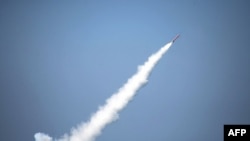The nuclear arsenals of several countries, especially China, grew last year and other atomic powers continued to modernize theirs as geopolitical tensions rise, researchers said Monday.
"We are approaching, or maybe have already reached, the end of a long period of the number of nuclear weapons worldwide declining," Dan Smith, director of the Stockholm International Peace Research Institute (SIPRI), told AFP.
The total amount of nuclear warheads among the nine nuclear powers — Britain, China, France, India, Israel, North Korea, Pakistan, Russia and the United States — was down to 12,512 at the outset of 2023, from 12,710 at the start of 2022, according to SIPRI.
Of those, 9,576 were in "military stockpiles for potential use," 86 more than a year earlier.
SIPRI distinguishes between countries' stockpiles available for use and their total inventory, which includes older ones scheduled to be dismantled.
"The stockpile is the usable nuclear warheads, and those numbers are beginning to tick up," Smith said, while noting that numbers are still far from the more than 70,000 seen during the 1980s.
The bulk of the increase was from China, which increased its stockpile from 350 to 410 warheads.
India, Pakistan and North Korea also upped their stockpiles and Russia's grew to a smaller extent, from 4,477 to 4,489, while the remaining nuclear powers maintained the size of their arsenal.
Russia and the United States together still have almost 90% of all nuclear weapons.
"The big picture is we've had over 30 years of the number of nuclear warheads coming down, and we see that process coming to an end now," Smith said.
Researchers at SIPRI also noted that diplomatic efforts on nuclear arms control and disarmament had suffered setbacks following Russia's invasion of Ukraine.
For instance, the United States suspended its "bilateral strategic stability dialogue" with Russia in the wake of the invasion.
In February, Moscow announced it was suspending participation in the 2010 Treaty on Measures for the Further Reduction and Limitation of Strategic Offensive Arms (New START).
SIPRI noted in a statement that it "was the last remaining nuclear arms control treaty limiting Russian and U.S. strategic nuclear forces."
At the same time, Smith said the increase in stockpiles could not be explained by the war in Ukraine as it takes a longer time to develop new warheads and that the bulk of the increase was among countries not directly affected.
China also has invested heavily in all parts of its military as its economy and influence have grown.
"What we're seeing is China stepping up as a world power, that is the reality of our time," Smith said.





